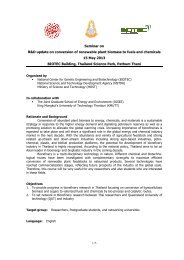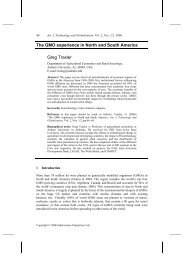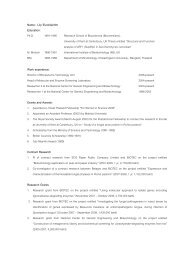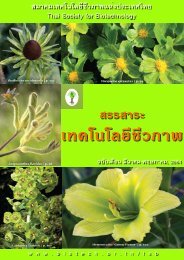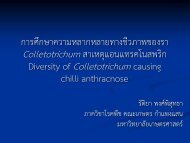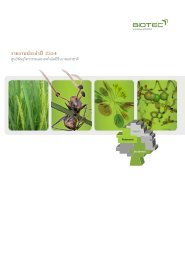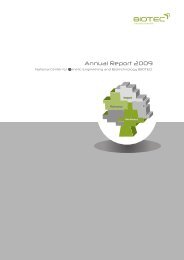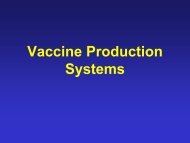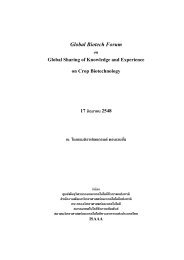Coastal Shrimp Aquaculture in Thailand: Key Issues for Research
Coastal Shrimp Aquaculture in Thailand: Key Issues for Research
Coastal Shrimp Aquaculture in Thailand: Key Issues for Research
Create successful ePaper yourself
Turn your PDF publications into a flip-book with our unique Google optimized e-Paper software.
!The 1994 Workshop had a work<strong>in</strong>g hypothesis that the pattern of development ofshrimp farm<strong>in</strong>g <strong>in</strong> coastal regions of <strong>Thailand</strong>—<strong>in</strong>volv<strong>in</strong>g a period of rapid expansionfollowed by a decl<strong>in</strong>e <strong>in</strong> many areas—had occurred largely because of environmentalproblems that impacted on the <strong>in</strong>dustry. The 1994 Workshop proposed thatthe 1995 shrimp farm survey 1 should be used to <strong>in</strong>vestigate this hypothesis and that amore comprehensive workshop should be held at a later date to def<strong>in</strong>e the researchableissues and prioritise them.Prelim<strong>in</strong>ary ReviewIn 1995, a prelim<strong>in</strong>ary review of the literature was carried out, and the f<strong>in</strong>d<strong>in</strong>gs <strong>for</strong>mthe basis <strong>for</strong> the chapter which follows (Jenk<strong>in</strong>s et al., this report). In summary, thereview found that the Thai shrimp farm<strong>in</strong>g <strong>in</strong>dustry is highly productive but alsofaces various constra<strong>in</strong>ts which are not always effectively addressed by research.Water quality problems and disease syndromes which cause crop failures have beenfocused upon by researchers, however, these events are, <strong>in</strong> most <strong>in</strong>stances, symptomsof underly<strong>in</strong>g constra<strong>in</strong>ts rather than the cause of unsusta<strong>in</strong>ability. <strong>Research</strong> is neededto address some of the fundamental constra<strong>in</strong>ts, and also to help farmers exploit theopportunities <strong>for</strong> susta<strong>in</strong>able development of the <strong>in</strong>dustry.The review identified a total of 25 key constra<strong>in</strong>ts that could be addressed byresearch:• The relationships between the quality of sediment <strong>in</strong> ponds, farm managementpractices and water quality.• The role of microbial populations <strong>in</strong> water quality improvement <strong>in</strong> rear<strong>in</strong>g pondsand the effect of currently used chemicals and probiotics.• The role of beneficial microbes <strong>in</strong> controll<strong>in</strong>g pathogenic organisms.• The role, if any, of a healthy cuticle and gut flora and healthy microbial populations<strong>in</strong> pond water on enhanc<strong>in</strong>g disease resistance <strong>in</strong> shrimp.• Identification of <strong>in</strong>dustrial and agricultural chemical pollutants <strong>in</strong> farm sourcewater and identification of their effects on shrimp growth and health.• Prediction of the occurrence of red tides and identification of reasons <strong>for</strong> theiroccurrence.• Assessment of the capacity of settlement ponds to improve pond <strong>in</strong>fluent/effluentwater quality. To <strong>in</strong>vestigate the efficiency of ponds of different configurations,so as to improve water quality <strong>in</strong> various production situations.• Assessment of the capacity of a range of plants and animals to remove wastesfrom effluent water.• Exam<strong>in</strong>ation of the capacity of natural and artificial wetlands to treat effluentwater.1. The survey was carried out by the Department of Fisheries and the Network of <strong>Aquaculture</strong> Centres <strong>in</strong>Asia–Pacific (NACA) with f<strong>in</strong>ancial support from the Asian Development Bank (ADB).'



